|

|
June 2004
|
Jaganadha Raju Nagar - A 'Model' Colony
(Inputs : Sarat Devara & P. Viswanath)
|
|
|
|
 In a country where most citizens have accepted and learned to live with the apathy of those responsible for providing civic services, here is a success story of association that transformed dreams into reality by banding together and participating as a community to restructure and maintain their colony, making it a model for others to emulate.
In a country where most citizens have accepted and learned to live with the apathy of those responsible for providing civic services, here is a success story of association that transformed dreams into reality by banding together and participating as a community to restructure and maintain their colony, making it a model for others to emulate.
Jaganadha Raju Nagar is located on the Northern approach to Visakhapatnam city adjacent to the National Highway. A decade ago, this locality, like most others, faced the usual problems of bad roads, street lights that didn't work, garbage not cleared, flooded streets during the rains which in turn created a breeding ground for mosquitoes (it is low-lying land). Rather than accepting it all or adopting a 'as-long-as-it-is-not-in-my-backyard' attitude, the residents of this colony decided to take up these matters with the powers that be. Some of the residents felt they would be better heard if they made their representations collectively to the Municipal Corporation, the Urban Development Authority and other similar authorities in a more effective manner. Accordingly on the 1st of January 1991, the Jaganadha Raju Nagar Resident's Welfare Association was formed (henceforth referred to as JRNRWA as that is quite a mouthful).
|
|
Since then there has been no turning back. The association's activities gathered momentum with more and more residents joining the JRNRWA. The result is there for all to see: the colony has good drains, tarred roads, placards promoting hygiene, garbage collection at their doorsteps, and a private army of two women who work continuously to keep the streets clean! A bus stop exclusively for Jaganadha Raju Nagar and a park are also being planned. Rather than work by themselves they have chosen to work with the Municipal Corporation and take part in their cleaning/greening programmes such as 'Subhram' and 'Janachaitanya'. The association brings out a quarterly newsletter and offers memberships to its residents including 'life membership'.
|
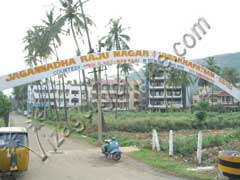 |
| Jaganadha Raju Nagar |
|
|
The work done by the JRNRWA and the results achieved have not gone unnoticed; they received compliments from none other than the President of India! Prof B.R.K. Raju says that the success of his association is the result of the collective effort of the residents of the J.R. Nagar community. His ambition is to make J.R. Nagar an exemplary colony not only for Vizag but for the entire country.
|
|
|
LALOO'S MUD ON VIZAG RAILWAY TRACKS
|
|
 Love him or hate him but you just can't ignore him. The new railway minister Mr. Laloo Prasad Yadav has made his presence felt once again - this time to the millions of railway passengers and railway staff. His decision to introduce cups made of terracotta (clay) commonly known as
kulhads, in the Indian Railways
along with Khadi (handwoven cloth) and Mhata
(buttermilk) has taken everyone by surprise. Well, not really. Nothing he does surprises anyone anymore. Love him or hate him but you just can't ignore him. The new railway minister Mr. Laloo Prasad Yadav has made his presence felt once again - this time to the millions of railway passengers and railway staff. His decision to introduce cups made of terracotta (clay) commonly known as
kulhads, in the Indian Railways
along with Khadi (handwoven cloth) and Mhata
(buttermilk) has taken everyone by surprise. Well, not really. Nothing he does surprises anyone anymore.
In Visakhapatnam too, the railway staff and vendors are doing their best to ensure the implementation of the decision without delay. Trouble is, the kulhads are not easily available (especially at such short notice and in such large quantities) and have to be imported from Calcutta. Local potters and self-help groups will be approached next.
How is the public taking it? Many railway passengers are still unaccustomed to these earthen cups and there are also concerns about their hygiene. Add to this the bitter taste in the tea/coffee due to an increase in price for the kulhad (between 40 & 70 paisa) and it is obvious that it is going to be some time before the mud is digestible! A tea seller in the railway station admits to a drop in sales ever since this was started.
Mr. Yadav is known for his quirks and this whim of his is giving headaches to quite a few. Whim or not, nobody is openly complaining as this is undeniably an extremely eco-friendly move with a side benefit of generating rural employment. |
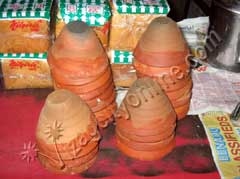 |
| Ready to serve |
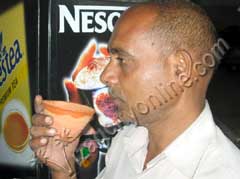 |
| Savouring the mud cup tea |
|
|
|
WORLD LIP-SERVICE DAY |
Another 'World Environment Day' was marked in Vizag on the 5th of June this year, as usual. Lip service was paid, resolutions were made and seminars were held, as usual. This year a special seminar was arranged by the Municipal Corporation with the theme (fixed by the United Nations Environment Program - UNEP) 'Wanted: Seas and Oceans - Dead or Alive'.
So much for seminars and resolutions. But what is the reality especially as far as the sea off Vizag is concerned? A few decades ago, large parts of the Vizag were covered with swamps and mangroves formed due to backwaters and lagoons which were abode to a variety of fishes, migratory birds, reptiles and other animals. It may seem a myth now but many older citizens of the city can still recollect their hunting experiences in what is now within the city limits.
The increase in population, the growth in the number of industries, the rise of fisheries sector and the expansion of the port are some of the major factors that have contributed to the complete disarray of the coastal eco-system in this region.
With population explosion and industrial progress, the disposal of enormous quantities of sewage that accumulates everyday has turned out to be a major problem. The only outlet seems to be the sea. Everyday, waste consisting of inorganic and indecomposable or imperishable substances like plastics, harmful chemicals and bio-medical wastes are released from industries, residential areas and hospital drains into the sea damaging the coastal ecosystem. The fresh water streams locally known as geddas have been turned into open sewage drains.
Vizag is now a hub of fishing activity where hundreds of fishing boats and trawlers relentlessly exploit the marine life on regular basis. Apart from fishing, another source of environmental damage is the unscientific practice of aquaculture on the shores of the city outskirts which is also polluting the underground water as well as destroying the marine bio-diversity. |
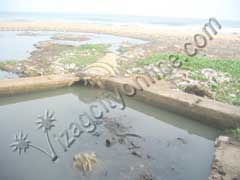 |
| City drain, draining into the sea |
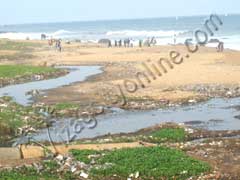 |
| Stagnated effluents near R.K. Beach |
 |
| Ruthless fishing, to cater to rising demand |
|
|
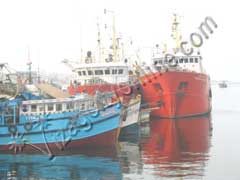 |
| Trawlers ready for a big hunt |
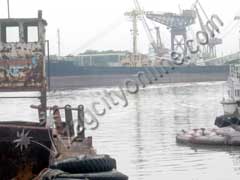 |
| An expanding port |
|
Another environmental crisis that is looming is large-scale erosion along the coastline in Vizag. The station director of the National Institute of Oceanography (NIO), Dr K. S. R. Murthy, says that the erosion is not only due to the global warming but also due to construction of break-waters and constant dredging that are necessary for navigation in the approaches to the port. Enjoying an outing to the sandy shores of Vizag's beaches may not be possible for much longer, adds Dr. Murthy.
One more expert in this field that we spoke to, Prof. Raman of Andhra University's Department of Eco-Studies, complains about the reluctance on the part of policy makers to implement and encourage baseline studies on Ocean Sciences.
So is all lost for Vizag as far as the Coastal Environment is concerned? Not if there is a unified, concerted effort by the powers that be, by research institutions, by NGOs and, just as important, the citizens of Vizag, says Prof. Raman.
And for those Vizagites who insist on carrying on their relentless rape of the sea, a warning:
"Nature takes revenge if you try to mend it" (Mahatma Gandhi). |
|
|
|
All that you wanted to know about mangoes
|
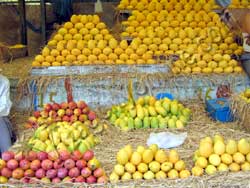 |
It's mango season again! Mangoes, mangoes everywhere and yet how much do you know about this fruit apart from the fact that it is yellow (not always), available in summer (there are exceptions) and delectable (always!)?
Andhra Pradesh is home to some of the most famous types of mangoes and the hot and humid weather of the region adds flavour and colour to the local mangoes. In terms of area under 'cultivation' our state stands second but in terms of crop quantity it stands a proud first. Out of the 1000 known types, 793 are available in India. 56% of the 2 crore metric tons of mangoes every year comes from India. |
|
|
In Vizag, Banginapalle is considered the King of mangoes with Suvarnarekha coming a close second. Alphonso, the popular Maharastrian variety is considered King by residents of those parts of the country though any loyal Vizagite would disagree.
From sunny yellow, to hues of orange and red, mangoes come in different types. We have classified them from a mango eater's point of view as follows:
Mangoes best cut & eaten:
These types have a relatively thicker skin and firmer flesh and are ideal for cutting and slicing and for using in desserts and puddings. Banginapalle, Alphonso, Langra, Kesar and Himayuddin come under this category.
Mangoes not suitable to be cut ('Rasams'):
These varieties have a relatively thinner skin, an extremely sweet, watery flesh and are not ideal for peeling and cutting. These mangoes are meant to be sucked after gently kneading the mango to get all the flesh softened and separated from the seed. This technique of eating requires a little practice.
Some varieties of rasams: Chinna Rasam, Pedda Rasam, Cheraku Rasam, Panchadara Kalasa, Suvarnareka, Neelam, Janardhan Pasand
Mangoes best eaten raw:
These are the variety that taste excellent when in the partially raw stage. Some like to eat it with chilli powder and coconut oil. They are also excellent with behl puri and can be found with vendors on the beach in Vizag. They are also used for pickles such as the famous 'avakaya'.
|
|
Here's some nutritional info about mangoes - decide for yourself whether you can afford to eat them or not! |
| Every 100 gms of Mango contains: |
|
Contents |
Mango Fruit |
Mango Raw |
| Protein (Grams) |
0.6 |
0.7 |
| Fat (Grams) |
0.4 |
0.1 |
| Fibre (Grams) |
0.7 |
1.2 |
| Minerals (Grams) |
0.4 |
0.4 |
| Carbohydrates (Grams) |
16.9 |
10.1 |
| Energy (Kilo Calories) |
74 |
44 |
| Vitamin C (Milligrams) |
16 |
3 |
| Carotene (Micrograms) |
2210 |
-- |
| Beta-carotene (Micrograms) |
1990 |
-- |
| Potassium (Milligrams) |
205 |
83 |
| Sodium (Milligrams) |
26 |
43 |
| Calcium (Milligrams) |
14 |
10 |
| Iron (Milligrams) |
1.3 |
0.33 |
| Phosphorous (Milligrams) |
16 |
19 |
|
|
|
Totapuri ('Collector kaya' in Vizag), Noojiveedu Sweet Mango, Yelamandala Sweet Mango, Shajahan, Kobbari Mamidi come under this category.
Mangoes available off-season:
Not all mangoes require the burning heat of the Indian summer to grow and ripen - some are available around the year. Mostly found on the west coast, the Baramasi is the only variety that can be found here. Some of them: Royal Special, Punasa, Baramasi, Chirutapudi Goa
|
|
Hybrid Mangoes:
These mangoes are unusually large and can weigh close to a kilo and a half. As the name indicates, these are hybrid varieties that are a cross between two types and are said to have the best qualities of their parents (eg: Banganapalle & Alphonso).
Some of the better known hybrids: Mallika, Amrapali, Ratna, Neeleshaan, Sindu, Arka Anmole, Arka Puneet, Arka Aruna
If you need to give a collective name to all these types of mangoes, try 'Mangifera Indica L' - the scientific name for the mango. |
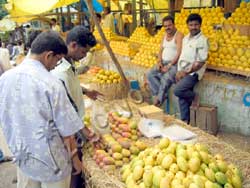 |
|
|
Back
|
|
 In a country where most citizens have accepted and learned to live with the apathy of those responsible for providing civic services, here is a success story of association that transformed dreams into reality by banding together and participating as a community to restructure and maintain their colony, making it a model for others to emulate.
In a country where most citizens have accepted and learned to live with the apathy of those responsible for providing civic services, here is a success story of association that transformed dreams into reality by banding together and participating as a community to restructure and maintain their colony, making it a model for others to emulate. 
 Love him or hate him but you just can't ignore him. The new railway minister Mr. Laloo Prasad Yadav has made his presence felt once again - this time to the millions of railway passengers and railway staff. His decision to introduce cups made of terracotta (clay) commonly known as
kulhads, in the Indian Railways
along with Khadi (handwoven cloth) and Mhata
(buttermilk) has taken everyone by surprise. Well, not really. Nothing he does surprises anyone anymore.
Love him or hate him but you just can't ignore him. The new railway minister Mr. Laloo Prasad Yadav has made his presence felt once again - this time to the millions of railway passengers and railway staff. His decision to introduce cups made of terracotta (clay) commonly known as
kulhads, in the Indian Railways
along with Khadi (handwoven cloth) and Mhata
(buttermilk) has taken everyone by surprise. Well, not really. Nothing he does surprises anyone anymore.







